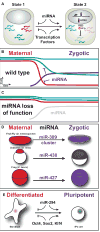microRNAs, the cell's Nepenthe: clearing the past during the maternal-to-zygotic transition and cellular reprogramming
- PMID: 20452200
- PMCID: PMC2908189
- DOI: 10.1016/j.gde.2010.04.003
microRNAs, the cell's Nepenthe: clearing the past during the maternal-to-zygotic transition and cellular reprogramming
Abstract
The maternal-to-zygotic transition (MZT) is a universal step in animal development characterized by two major events: activation of zygotic transcription and degradation of maternally provided mRNAs. How zygotic gene products instruct the degradation of maternal messages remains a long-standing question in biology. MicroRNAs (miRNAs) have recently emerged as widespread regulators of gene expression. miRNAs control temporal and spatial gene expression by both accelerating the decay of mRNAs from previous developmental stages and modulating the levels of actively transcribed genes. In this review, I discuss recent studies of the roles of miRNAs during the maternal-to-zygotic transition and cellular reprogramming, where they reshape transcriptional landscapes to facilitate the establishment of novel cellular states.
Figures


Similar articles
-
Temporal reciprocity of miRNAs and their targets during the maternal-to-zygotic transition in Drosophila.Curr Biol. 2008 Apr 8;18(7):501-6. doi: 10.1016/j.cub.2008.02.081. Curr Biol. 2008. PMID: 18394895
-
Regulatory principles governing the maternal-to-zygotic transition: insights from Drosophila melanogaster.Open Biol. 2018 Dec;8(12):180183. doi: 10.1098/rsob.180183. Open Biol. 2018. PMID: 30977698 Free PMC article. Review.
-
Evolution of maternal and zygotic mRNA complements in the early Drosophila embryo.PLoS Genet. 2018 Dec 17;14(12):e1007838. doi: 10.1371/journal.pgen.1007838. eCollection 2018 Dec. PLoS Genet. 2018. PMID: 30557299 Free PMC article.
-
The zinc-finger protein Zelda is a key activator of the early zygotic genome in Drosophila.Nature. 2008 Nov 20;456(7220):400-3. doi: 10.1038/nature07388. Epub 2008 Oct 19. Nature. 2008. PMID: 18931655 Free PMC article.
-
Transcript clearance during the maternal-to-zygotic transition.Curr Opin Genet Dev. 2011 Aug;21(4):431-43. doi: 10.1016/j.gde.2011.03.003. Epub 2011 Apr 14. Curr Opin Genet Dev. 2011. PMID: 21497081 Review.
Cited by
-
Molecular changes during egg activation.Curr Top Dev Biol. 2013;102:267-92. doi: 10.1016/B978-0-12-416024-8.00010-6. Curr Top Dev Biol. 2013. PMID: 23287037 Free PMC article. Review.
-
Co-activation of microRNAs by Zelda is essential for early Drosophila development.Development. 2014 May;141(10):2108-18. doi: 10.1242/dev.108118. Epub 2014 Apr 24. Development. 2014. PMID: 24764079 Free PMC article.
-
Characteristics of miRNAs Present in Bovine Sperm and Associations With Differences in Fertility.Front Endocrinol (Lausanne). 2022 May 19;13:874371. doi: 10.3389/fendo.2022.874371. eCollection 2022. Front Endocrinol (Lausanne). 2022. PMID: 35663333 Free PMC article.
-
The Maternal-to-Zygotic Transition During Vertebrate Development: A Model for Reprogramming.Curr Top Dev Biol. 2015;113:191-232. doi: 10.1016/bs.ctdb.2015.07.020. Epub 2015 Aug 13. Curr Top Dev Biol. 2015. PMID: 26358874 Free PMC article. Review.
-
DUX-miR-344-ZMYM2-Mediated Activation of MERVL LTRs Induces a Totipotent 2C-like State.Cell Stem Cell. 2020 Feb 6;26(2):234-250.e7. doi: 10.1016/j.stem.2020.01.004. Cell Stem Cell. 2020. PMID: 32032525 Free PMC article.
References
-
- Farley BM, Ryder SP. Regulation of maternal mRNAs in early development. Crit Rev Biochem Mol Biol. 2008;43:135–162. - PubMed
-
-
Tadros W, Lipshitz HD. The maternal-to-zygotic transition: a play in two acts. Development. 2009;136:3033–3042.. This review provides an extensive and thorough overview of the maternal-to-zygotic transition beyond the role of miRNAs, including our current understanding of the zygotic genome activation and other mechanisms of maternal clearance.
-
-
- Bashirullah A, Halsell SR, Cooperstock RL, Kloc M, Karaiskakis A, Fisher WW, Fu W, Hamilton JK, Etkin LD, Lipshitz HD. Joint action of two RNA degradation pathways controls the timing of maternal transcript elimination at the midblastula transition in Drosophila melanogaster. Embo J. 1999;18:2610–2620. - PMC - PubMed
Publication types
MeSH terms
Substances
Grants and funding
LinkOut - more resources
Full Text Sources
Molecular Biology Databases
Miscellaneous

